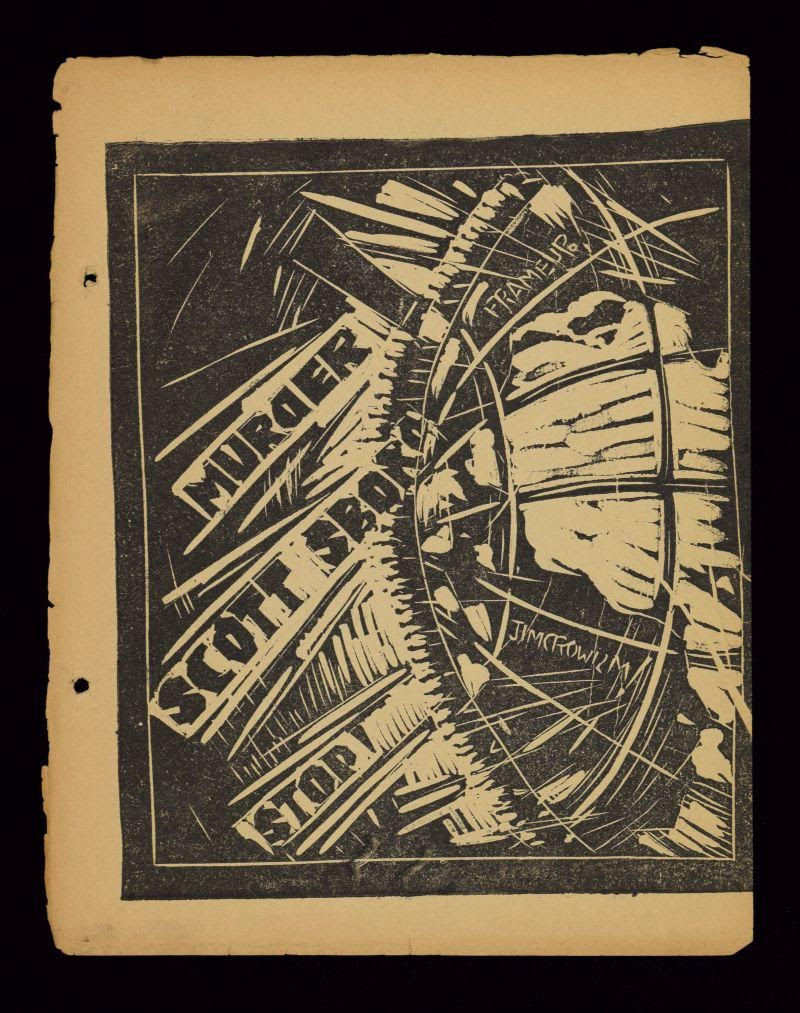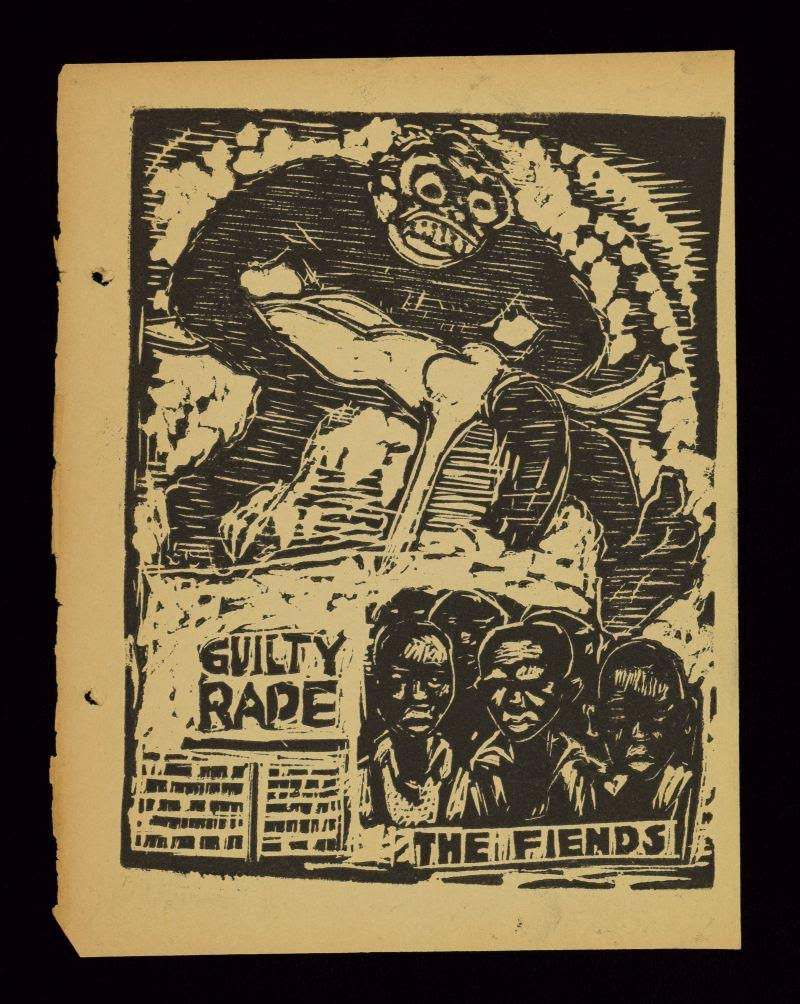"Scottsboro Alabama: A Story in Linoleum Cuts" and the beginnings of alternative graphic novel
- (WR)

- Aug 18, 2018
- 6 min read
Updated: Jan 12
A group of linocut prints from the early graphic novel “Scottsboro Alabama: A Story in Linoleum Cuts by Lin Shi Khan and Tony Perez”, 1935 edition, has recently arrived at the studio.

The Scottsboro Case
The Scottsboro Case, of 1931-1937, was at the time not only the most complicated, but also the most important civil rights case in the United States, resulting in two Supreme Court decisions and a nation-wide discussion about what was often viewed as “legal lynching”, because even though the defendants weren’t actually executed, the proper observance of due legal process lead to a decision widely seen as unfair.
On May 25, 1931, a group of white and black men and women rode a freight train to Memphis. There were 9 black teenagers, some hoping to find government founded jobs in Memphis - hauling logs on the river, some simply hoboing. There were also about a dozen white men in a similar situation, and two white women coming back from failed attempt to get employment in cotton mills. Near Stevenson, one of the white boys tried to force Haywood Patterson, a black teenager, off the train, claiming it was “a white man’s train”. The fight that started was eventually lost by whites who jumped the train and reported an assault by a black gang to the stationmaster in Stevenson. In Pint Rock, Alabama, a posse deputized by sheriff stopped the train and rounded up all the black teenagers they could find. Nine were arrested and taken to Scottsboro jail. While interrogated, one of the two white girls told the deputies she had been raped by a gang of 12 blacks who had knives and pistols. News of her confession almost led to lynch; the mob surrounded the jail the same night and only the National Guard, acting on direct orders from Alabama governor, managed to prevent the murder.
Six of the boys denied even seeing the girls, while three others confessed to witness the rape, only to retract the statements later, claiming they were given under torture. The medical examination of both victims done just after reporting crime found no signs of rape. The lack of evidence and conflicted, incomplete statements of witnesses turned out to be irrelevant for the outcome. The prevailing sentiment among the public opinion in the South at the time was that the black men were certainly guilty. The two lawyers originally assigned to defend the “Scottsboro Boys” weren’t of much help. On April 9, 1931 a death sentence was handed to 8 of the convicted defendants, while the 9th, 13-year-old Roy Wright, was found too young for the death penalty (in his case a mistrial was eventually declared).
The appeals were filed, the Alabama Supreme Court issued indefinite stay of executions and a much more serious legal battle began when The National Association for the Advancement of Colored People (NAACP) and the Communist Party USA took an interest in the Scottsboro case. The party convinced boy’s parents to accept the legal help of the International Labor Defense, party’s legal arm, in further proceedings. We can only speculate if the NAACP itself could have been a better choice. As it happened, the Scottsboro Case, originally a part of a racial struggle became also a part in political power play. The medial and political coverage of the case provides an early example of a divisive info-war, with progressive and conservative forces actively trying to influence trends in public opinion and to persuade the public to take specific point of view.

The Artists
“Scottsboro Alabama: A Story in Linoleum Cuts by Lin Shi Khan and Tony Perez”, published in Seattle, in 1935, was one of the first and most powerful graphic narratives of the story. According to editors of the 2002 NYU reprinted version, Tony Perez was probably a printmaker, since a print maker by this name has been active in Seattle area until mid-1960s. Literally nothing is known about co-author, Lin Shi Khan. Dora Apfel, a professor of art history at the Wayne State College, Detroit, in her very informative work “Imagery of Lynching: Black Men, White Women, and the Mob” (Rutgers University Press, 2004), identifies Lin Shi Khan as “a Japanese artist”. Unfortunately, with no reference given, the source of this information remains unknown, and the identification is unusual from the socio-linguistic point of view. Both Chinese and Japanese names are written in Chinese characters (sometimes slightly modified in Japanese version), but they are vocalized in a very different way - according to different rules of both languages. Lin Shi Khan is a romanized version of distinctly Chinese pronunciation. In Japan, Chinese names, without exception, have to undergo Japanization; for example, the name “Mao Zedong” is pronounced “Mo-Takuto” in Japanese. Lin Shi Khan had chosen the Chinese pronunciation of his name, stressing his Chinese nationality.
Interestingly, while “Lin Shi” is a popular name everywhere in China, Khan is a name of Mongolian origin (know better in its early form as a tribe’s chief title) and within Chinese population is popular mostly among the Manchurian – Jurchen people in Northeast China. In 1932, when Japan created the puppet state of Manchukuo and started the de facto occupation of Manchuria, many people had to fled their homeland, running away from slave labor or/and political persecution. Was Lin Shi Khan, an artist, one of them? Right now, the name is the only clue, but it may be a possible direction for future research.

The Art of Scottsboro Prints
“Scottsboro Alabama: A Story in Linoleum Cuts” is basically a linocut novel, a variation upon a wordless woodcut novel, a relatively new genre in the 1930’s, and one of the predecessors of later comic books. The most prominent author of woodcut novels of the time was Lynn Ward, the “grandfather of American graphic novel”. Despite similar genre, the difference between Khan’s Scottsboro prints and any example of Ward’s woodcut novels is striking. Both represent very different artistic traditions. Ward was a student of a German artist, Hans Alexander “Theodore” Mueller, a well known teacher of wood engraving at the National Academy of Graphic Arts and Bookmaking in Leipzig; an art teacher by profession, and an author of the classic “Woodcuts and Wood Engravings”. Just like in Mueller’s art, in Ward's novels the influences of German expressionism are toned down and filtered by carefully laid-out structure; a viewer can trace there influences of surrealism mixed with a slight neo-academic flavor (possibly related to Mueller). Ward carefully designs his composition along sophisticated perspective, often strikingly exaggerated and accentuated with strong contrast of light and shadow and purposely distorted to match the imagery of familiar, but at the same time disturbingly unreal world. Elements of Ward's artistic concepts even though modified, dominated the mainstream graphic novels of later years. The technique that
Lin Shi Khan shares with Ward is the strong contrast of light and dark forms. Contrary to Ward's phantasmagoric universe, Khan's images represent a very real world in as straightforward manner as only possibly. Ostensibly “accidental”, unpolished composition, simple, powerful crude forms, resembling folk art, everything seems much closer to German expressionism and Russian revolutionary experiments with futurism, both depicting social conflict. In fact, the very words the MoMA curator wrote about German expressionism, could be said about Lin Shi Khan and Perez work: “starkly simplified woodcuts capitalize on the medium's potential for bold, flat patterns and rough hewn effects”. At the same time, Khan carefully maintains a dynamic balance of forms and colors, a technique present in various artistic styles but typical for East Asian woodblock prints, from China to Japan. Lin Shi Khan's simplification of forms and dynamism of his composition express a powerful social message; the linocut novel defends the Scottsboro Boys and condemns their persecutors through artistic presentation of facts.
Georg Grosz said about his art: "I drew and painted out of a spirit of contradiction, trying in my works to convince the world that it was ugly, sick, and mendacious.” Lin Shi Khan, in his linocut novel, painted an ugly, racist world that disseminated mendacious, aggressive propaganda campaign, demanding – and eventually achieving – capital punishment sentences for the Scottsboro Boys. And just like Lynn Ward started the main line of American graphic novels, Khan’s work can be seen as the foundation for the much later alternative comics.
_________________
All images in text from private collection, before treatment.




Comments